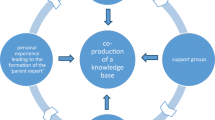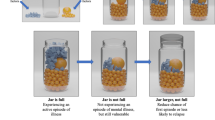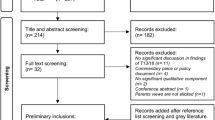Abstract
Trisomy 13 and 18 (T 13/18) are rare chromosomal abnormalities associated with high morbidity and mortality. Improved survival rates and increased prevalence of aggressive medical intervention have resulted in families and physicians holding different perspectives regarding the appropriate management of children with T 13/18. Families were invited for open-ended interviews regarding their experiences with the medical care of a child with T 13/18 over the past 5 years. Seven of 33 invited families were surveyed; those who had spent more than 40 days in the hospital were most likely to accept the invitation (OR 8.8, p = 0.02). Grounded theory technique was used to analyze the interviews. This method elicited four key themes regarding family perspectives on children with T 13/18: (1) they are unique and significant, (2) they transform the lives of others, (3) their families can feel overwhelmed and powerless in the medical setting, (4) their families are motivated to “carry the torch” and tell their story. Families also emphasized ways in which Internet support groups can provide both positive and negative perspectives. The ensuing discussion explores the difficulties of parents and physicians in forecasting the impact that T 13/18 will have on families and emphasizes a narrative approach to elicit a map of the things that matter to them. The paper concludes that while over-reliance on dire prognostic data can alienate families, examining the voice, character and plot of patient stories can be a powerful way for physicians to foster shared decision-making with families.
Similar content being viewed by others
Notes
Digoxin is a cardiac medication.
References
Quotes from interviews are marked by subject number. Transcriptions are not available for public viewing under IRB restrictions.
Bishop, J. P. (2011). The anticipatory corpse: Medicine, power, and the care of the dying. Notre Dame: University of Notre Dame Press.
Charmaz, K. (2014). Constructing grounded theory (introducing qualitative methods). London: Thousand Oaks.
Charon, R. (2007). What to do with stories: The sciences of narrative medicine. Canadian Family Physician, 53(8), 1265–1267.
Davis, D. S. (1997). Genetic dilemmas and the child’s right to an open future. Hastings Center Report, 27(2), 7–15.
Donohue, P. K., Boss, R. D., Aucott, S. W., Keene, E. A., & Teague, P. (2010). The impact of neonatologists’ religiosity and spirituality on health care delivery for high-risk neonates. Journal of Palliative Medicine, 13(10), 1219–1224. doi:10.1089/jpm.2010.0049.
Guon, J., Wilfond, B. S., Farlow, B., Brazg, T., & Janvier, A. (2014). Our children are not a diagnosis: The experience of parents who continue their pregnancy after a prenatal diagnosis of trisomy 13 or 18. American Journal of Medical Genetics. Part A, 164(2), 308.
Halpern, J., & Arnold, R. M. (2008). Affective forecasting: An unrecognized challenge in making serious health decisions. Journal of General Internal Medicine, 23(10), 1708–1712. doi:10.1007/s11606-008-0719-5.
Janvier, A., Farlow, B., & Wilfond, B. S. (2012). The experience of families with children with trisomy 13 and 18 in social networks. Pediatrics, 130(2), 293–298. doi:10.1542/peds.2012-0151.
Josephsen, J. B., Armbrecht, E. S., Braddock, S. R., & Cibulskis, C. C. (2016). Procedures in the 1st year of life for children with trisomy 13 and trisomy 18, a 25-year, single-center review. American Journal of Medical Genetics Part C: Seminars in Medical Genetics, 172(3), 264–271. doi:10.1002/ajmg.c.31525.
Kosho, T., Kuniba, H., Tanikawa, Y., Hashimoto, Y., & Sakurai, H. (2013). Natural history and parental experience of children with trisomy 18 based on a questionnaire given to a Japanese trisomy 18 parental support group. American Journal of Medical Genetics Part A, 161a(7), 1531–1542. doi:10.1002/ajmg.a.35990.
Kukla, R. (2007). How do patients know? Hastings Center Report, 37, 27–35.
Kumar, P. (2011). Care of an infant with lethal malformation: Where do we draw the line? Pediatrics, 128(6), e1642–1643; author reply e1643-1644. doi: 10.1542/peds.2011-2869A.
Lakovschek, I. C., Streubel, B., & Ulm, B. (2011). Natural outcome of trisomy 13, trisomy 18, and triploidy after prenatal diagnosis. American Journal of Medical Genetics Part A, 155a(11), 2626–2633. doi:10.1002/ajmg.a.34284.
Maeda, J., Yamagishi, H., Furutani, Y., Kamisago, M., Waragai, T., Oana, S., et al. (2011). The impact of cardiac surgery in patients with trisomy 18 and trisomy 13 in Japan. American Journal of Medical Genetics Part A, 155a(11), 2641–2646. doi:10.1002/ajmg.a.34285.
McGraw, M. P., & Perlman, J. M. (2008). Attitudes of neonatologists toward delivery room management of confirmed trisomy 18: Potential factors influencing a changing dynamic. Pediatrics, 121(6), 1106–1110. doi:10.1542/peds.2007-1869.
Meyer, R. E., Liu, G., Gilboa, S. M., Ethen, M. K., Aylsworth, A. S., Powell, C. M., et al. (2016). Survival of children with trisomy 13 and trisomy 18: A multi-state population-based study. American Journal of Medical Genetics Part A, 170a(4), 825–837. doi:10.1002/ajmg.a.37495.
Montello, M. (2014). Narrative ethics. Hastings Center Report, 44(1 Suppl), S2–S6. doi:10.1002/hast.260.
Moorhead, S. A., Hazlett, D. E., Harrison, L., Carroll, J. K., Irwin, A., & Hoving, C. (2013). A new dimension of health care: Systematic review of the uses, benefits, and limitations of social media for health communication. Journal of Medical Internet Research, 15(4), e85. doi:10.2196/jmir.1933.
Nelson, K. E., Hexem, K. R., & Feudtner, C. (2012). Inpatient hospital care of children with trisomy 13 and trisomy 18 in the United States. Pediatrics, 129(5), 869–876. doi:10.1542/peds.2011-2139.
Peters, S. A., Laham, S. M., Pachter, N., & Winship, I. M. (2014). The future in clinical genetics: Affective forecasting biases in patient and clinician decision making. Clinical Genetics, 85(4), 312–317. doi:10.1111/cge.12255.
Powell, J., Inglis, N., Ronnie, J., & Large, S. (2011). The characteristics and motivations of online health information seekers: Cross-sectional survey and qualitative interview study. Journal of Medical Internet Research, 13(1), e20. doi:10.2196/jmir.1600.
Wilkinson, D. J. (2010). Antenatal diagnosis of trisomy 18, harm and parental choice. Journal of Medical Ethics, 36(11), 644–645. doi:10.1136/jme.2010.040212.
Acknowledgements
The authors appreciate support received from Saint Louis University and SSM Health Cardinal Glennon Children’s Hospital. Saint Louis University Department of Pediatrics provided the funding for this research.
Funding
This study was funded by the Saint Louis University Department of Pediatrics, Award Number: 2-00330.
Author information
Authors and Affiliations
Corresponding author
Ethics declarations
Conflict of interest
The authors declare that they have no conflict of interest.
Ethical Approval
All procedures performed in studies involving human participants were in accordance with the ethical standards of the institutional and/or national research committee and with the 1964 Helsinki declaration and its later amendments or comparable ethical standards.
Informed Consent
Informed consent was obtained from all individual participants included in the study.
Rights and permissions
About this article
Cite this article
Arthur, J.D., Gupta, D. “You Can Carry the Torch Now:” A Qualitative Analysis of Parents’ Experiences Caring for a Child with Trisomy 13 or 18. HEC Forum 29, 223–240 (2017). https://doi.org/10.1007/s10730-017-9324-5
Published:
Issue Date:
DOI: https://doi.org/10.1007/s10730-017-9324-5




